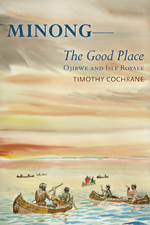LANSING–In many ways, Michigan is a state of connections, including historic links between the Ojibwe people of Minnesota and Isle Royale. Such connections can be explored in words and pictures that illuminate the linkages that bind land and water, peoples and places, present and past.
Minong — The Good Place (Michigan State University Press, $24.49) provides an in-depth account of the intimate relationship between the North Shore Ojibwe people and Isle Royale, which is now a national park in Lake Superior off the west coast of the Upper Peninsula.
Timothy Cochrane, the former national park historian, describes how the Grand Portage Band had used the island and its resources, including the prized siscowet trout, the caribou that became especially prized when mainland moose numbers dropped in the 1800s, the beaver whose skins were traded and the maple syrup produced in the spring.
The Ojibwe were involved in copper mining on the island, as well as commercial fishing operations.
In addition, Cochrane writes that “islands play a seminal role in Ojibwe oral tradition,” and one myth holds that the trickster Nanabushu uses mud from near Isle Royale to recreate the earth after its destruction by a great flood.
As time passed, however, several factors diminished the band’s engagement on the island, including treaties, diseases such as smallpox, changes in fishing operations, depleted game and the encroachment of white settlers on traditional tribal lands on the mainland.
“Ironically, as real Ojibwe use of Minong was in decline, less authentic examples of an Indian past were fabricated,” Cochrane writes. “A rock outcrop along the Rock Harbor Channel, named the `Great Indian Head,’ was marketed for tourists to visit. And to impress the passengers on the steamship America, the owners of the Belle Isle Resort erected a cement teepee and had an employee dressed as an `Indian maiden’ greet oncoming vessels.”
In another piece of irony, the well-meaning move intended to preserve the island for the greater public by creating a national park in 1946 proved to be the low point of the Ojibwes’ relationship with Isle Royale, according to Cochrane. They were not consulted in advance, and the park brought them few economic opportunities.
Only later was the relationship between the tribal council and the national park reworked, with the two sides now communicating about such matters as treaty rights, jobs, the fishery, cultural-resource research and invasive species, he writes.
In addition, there is now better recognition of the band’s cultural connections with Isle Royale and the fact that it was “an Ojibwe homeland — a place of bungled treaties and an island where hunters, fishers and plant gatherers made use and intimately knew Minong resources,” not a wilderness with little human history.
Eric Freedman teaches journalism at Michigan State University
